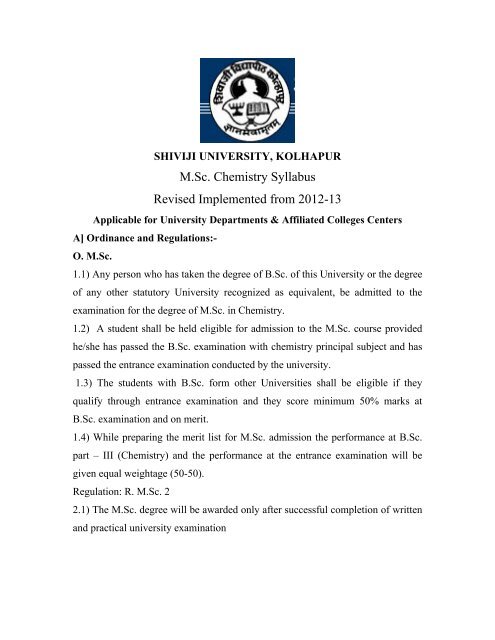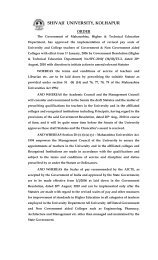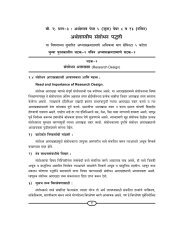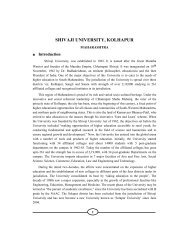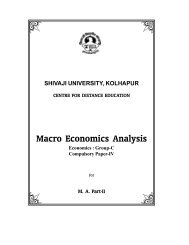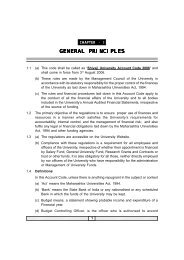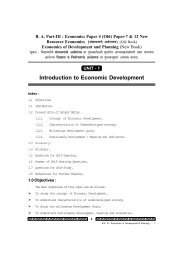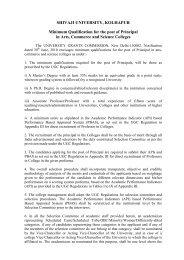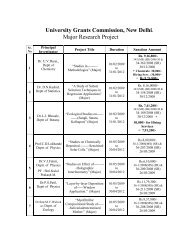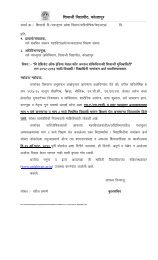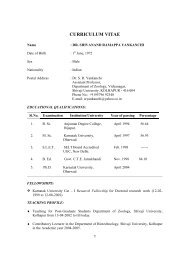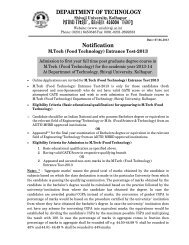M.Sc. Chemistry Syllabus Revised Implemented ... - Shivaji University
M.Sc. Chemistry Syllabus Revised Implemented ... - Shivaji University
M.Sc. Chemistry Syllabus Revised Implemented ... - Shivaji University
You also want an ePaper? Increase the reach of your titles
YUMPU automatically turns print PDFs into web optimized ePapers that Google loves.
SHIVIJI UNIVERSITY, KOLHAPUR<br />
M.<strong>Sc</strong>. <strong>Chemistry</strong> <strong>Syllabus</strong><br />
<strong>Revised</strong> <strong>Implemented</strong> from 2012-13<br />
Applicable for <strong>University</strong> Departments & Affiliated Colleges Centers<br />
A] Ordinance and Regulations:-<br />
O. M.<strong>Sc</strong>.<br />
1.1) Any person who has taken the degree of B.<strong>Sc</strong>. of this <strong>University</strong> or the degree<br />
of any other statutory <strong>University</strong> recognized as equivalent, be admitted to the<br />
examination for the degree of M.<strong>Sc</strong>. in <strong>Chemistry</strong>.<br />
1.2) A student shall be held eligible for admission to the M.<strong>Sc</strong>. course provided<br />
he/she has passed the B.<strong>Sc</strong>. examination with chemistry principal subject and has<br />
passed the entrance examination conducted by the university.<br />
1.3) The students with B.<strong>Sc</strong>. form other Universities shall be eligible if they<br />
qualify through entrance examination and they score minimum 50% marks at<br />
B.<strong>Sc</strong>. examination and on merit.<br />
1.4) While preparing the merit list for M.<strong>Sc</strong>. admission the performance at B.<strong>Sc</strong>.<br />
part – III (<strong>Chemistry</strong>) and the performance at the entrance examination will be<br />
given equal weightage (50-50).<br />
Regulation: R. M.<strong>Sc</strong>. 2<br />
2.1) The M.<strong>Sc</strong>. degree will be awarded only after successful completion of written<br />
and practical university examination
R. M.<strong>Sc</strong>. 4:<br />
1) The entire course of M.<strong>Sc</strong>. shall be of 2400 marks so that each semester shall<br />
have 600 marks i.e. 400 Theory + 200 practical. There shall be internal evaluation<br />
of 20% for theory papers.<br />
4.2) The examination shall be split up into four semesters.<br />
4.3) The commencement and conclusion of each semester shall be notified by the<br />
university from time to time<br />
4.4) There shall be a university examination for theory and practicals at end of<br />
each semester. The evaluation of theory and practicals examination be done by<br />
internal and external examiners (50:50)<br />
4.5) In each semester there shall four theory papers and two practical courses.<br />
4.6) A student who has passed in semester examination shall not be allowed to<br />
take the examination in the same semester again.<br />
4.7) Each theory papers in each semester as well as each practical course shall be<br />
treated as separate head of passing.<br />
4.8) The student is allowed to keep term in the III semester even if he/she has<br />
failed in three papers<br />
4.9) The result shall be declared at the end of each semester examination as per<br />
<strong>University</strong> rule<br />
B] <strong>Shivaji</strong> <strong>University</strong>, Kolhapur.<br />
<strong>Revised</strong> <strong>Syllabus</strong> for Master of <strong>Sc</strong>ience<br />
1. TITLE: Subject:- <strong>Chemistry</strong> ( Inorganic , Organic, Physical and<br />
Analytical )<br />
Compulsory under the faculty of <strong>Sc</strong>ience<br />
2. YEAR OF IMPLIMENTATION :<br />
New <strong>Syllabus</strong> will be implemented from June 2012 on wards.<br />
3. PREAMBLE : (Applicable to <strong>University</strong> Department and<br />
<strong>University</strong> affiliated colleges centers)<br />
Total No. of Semester – 4<br />
2
(Two semesters per year)<br />
Total No. of Papers – 16<br />
Total No. of Practical course – 08<br />
No. of papers (theory) per semester – 04<br />
No. of practicals course per semester – 2<br />
Maximum marks per paper (practical) 100<br />
Distribution of Marks – Internal evaluation 20<br />
External evaluation 80<br />
(Semester exam.)<br />
Total Marks for M.<strong>Sc</strong>. Degree<br />
Theory Papers 1600<br />
Practical course 800<br />
2400<br />
3
4. GENERAL OBJECTIVES OF THE COURSE:<br />
<strong>Chemistry</strong> is a pervasive subject. All the branches of science need chemistry. It<br />
is an experimental science and students need to train in practicals to get<br />
expertise in doing fine experiments and handle sophisticated instruments.<br />
Along with the data obtained its statistical analysis is also required to establish<br />
authenticity in the fields like environmental science, space chemistry and<br />
biotechnology. There are immense potentialities for chemistry post graduates<br />
to undertake advanced research or in Industries as skilled chemists.<br />
5. Duration:<br />
• The Course shall be a full time course<br />
• The duration of course shall be two years consist of four semesters<br />
FEE STRUCTURE:<br />
Entrance Examination Fees : As prescribed by <strong>Shivaji</strong><br />
<strong>University</strong>, Kolhapur<br />
Course Fee : As prescribed by <strong>Shivaji</strong><br />
<strong>University</strong>, Kolhapur.<br />
6. IMPLEMENTATION OF FEE STRUCTURE: --<br />
7. ELGIBILITY FOE ADMISSION:<br />
As per O.M.<strong>Sc</strong>. 1.2 for graduates of this university and O.M.<strong>Sc</strong>. 1.3<br />
from other Universities and the merit list.<br />
8. MEDIUM OF INSTRUCTION : English.<br />
9. STRUCTURE OF COURSE:<br />
SEMESISTER<br />
Semester - I<br />
Theory courses: Paper No. Title<br />
G-11101 CH- I : Inorganic <strong>Chemistry</strong>.-I<br />
G-11201 CH-II : Organic <strong>Chemistry</strong>.-I<br />
G-11301 CH-III : Physical <strong>Chemistry</strong>-I.<br />
G-11401 CH-IV : Analytical <strong>Chemistry</strong>-I.<br />
Practical courses :<br />
G-11601 CH-111- I Relevant practicals.<br />
G-11701 CH-112-II<br />
4
Semester -II<br />
Theory courses Paper No. Title of paper.<br />
G-21101 CH-V Inorganic <strong>Chemistry</strong> - II.<br />
G-21201 CH-VI Organic <strong>Chemistry</strong> - II.<br />
G-21301 CH-VII Physical <strong>Chemistry</strong> - II.<br />
G-21401 CH-VIII Analytical <strong>Chemistry</strong> -II.<br />
Practicals courses<br />
G-21601 CH-211-III<br />
G-21701 CH-212-IV<br />
M.<strong>Sc</strong>.-II (General outline for each Branch).<br />
Following codes will be used for papers of Part-II.<br />
ICH : Inorganic chemistry<br />
OCH : Organic chemistry<br />
PCH : Physical chemistry.<br />
ACH : Analytical chemistry.<br />
Semester – III.<br />
The students shall opt. three papers and one elective in each specialization.<br />
Theory courses:<br />
Inorganic chemistry : Core papers : ICH-IX, ICH-X, ICH-XI<br />
Elective : ICH- XII (A to C)<br />
Organic chemistry : Core papers : OCH-IX, OCH-X, OCH-XI,<br />
Elective : OCH- XII (A to C).<br />
Physical chemistry : Core papers : PCH-IX, PCH-X, PCH-XI,<br />
Elective : PCH-XII (A to C).<br />
Analytical chemistry : Core papers : ACH-IX, ACH-X, ACH-XI,<br />
Elective : ACH-XII (A to C).<br />
Practical courses :<br />
Semester – III<br />
Two practical courses relevant to each Specilization : Practicals<br />
Inorganic <strong>Chemistry</strong> : ICH- 311 and ICH- 312, V&VI<br />
Orgnanic <strong>Chemistry</strong> : OCH-311 and OCH-312, V&VI<br />
Physical <strong>Chemistry</strong> : PCH-311 and PCH-312. V&VI<br />
Analytical <strong>Chemistry</strong> : ACH-311 and ACH-312. V&VI<br />
5
Semester– IV<br />
The students shall opt. three papers and one elective in each specialization.<br />
Theory courses :<br />
Inorganic chemistry : Core papers : ICH-XIII, ICH-XIV, ICH-XV<br />
Elective : ICH- XVI ( A to C)<br />
Organic chemistry : Core papers : OCH-XIII, OCH-XIV, OCH-XV,<br />
Elective : OCH- XVI (A to C).<br />
Physical chemistry : Core papers : PCH-XIII, PCH-XIV, PCH-XV,<br />
Elective : PCH-XVI (A to C)<br />
Analytical chemistry : Core papers : ACH-XIII, ACH-XIV, ACH-XV,<br />
Elective : ACH-XVI (A to C).<br />
Practicals<br />
Two practical courses relevant to each Specialization : Practicals<br />
Inorganic <strong>Chemistry</strong> : ICH- 411 and ICH- 412, VII&VIII<br />
Orgnanic <strong>Chemistry</strong> : CH-411 and OCH-412, VII&VIII<br />
Physical <strong>Chemistry</strong> : PCH-411 and PCH-412. VII&VIII<br />
Analytical <strong>Chemistry</strong> : ACH-411 and ACH-412. VII&VIII<br />
10. 1.3 <strong>Sc</strong>heme of examination : (Applicable to <strong>University</strong><br />
Department and <strong>University</strong> affiliated colleges centers)<br />
• The semester examination will be conducted at the end of each term (both<br />
theory and practical examination)<br />
• Theory paper will be of 80 marks each and 20 marks for internal evaluation<br />
test conducted in the mid of the term. Two practicals will be of 100 marks<br />
each.<br />
• Question papers will be set in the view of the entire syllabus and preferably<br />
covering each unit of the syllabus.<br />
1.4 Standard of Passing<br />
As per rules and regulation of M.<strong>Sc</strong>. course.<br />
1.5 Nature of question paper and scheme of marking<br />
Theory question paper: Maximum marks -80<br />
Total No. of question – 7<br />
6
All questions are of equal marks. Out of these seven questions five<br />
questions are to be attempted.<br />
Question No.1 is compulsory and objective<br />
Total no. of bits – 16, Total marks – 16 (which cover multiple choices, fill<br />
in the blanks, definition, true or false). These questions will be answered<br />
along with other questions in the same answer book.<br />
.Remaining 6 question are divided into two sections, namely section-I and<br />
section – II. Four questions are to be attempted from these two section such<br />
that not more than two questions from any of the section. Both sections are<br />
to be written in the same answer book.<br />
1.4 Standard of Passing<br />
As per rules and regulation of M.<strong>Sc</strong>. course.<br />
C] OTHER FEATURES : <strong>University</strong> Department<br />
INTAKE CAPACITY : 96 Students Organic: 30<br />
Inorganic: 30<br />
Physical: 20<br />
Analytical:16<br />
<strong>University</strong> affiliated College<br />
Centers :Self Supporting<br />
courses<br />
INTAKE CAPACITY : 20 students for each center.<br />
D) Laboratory Safety Equipments:<br />
Part: I Personal Precautions:<br />
1. All persons must wear safety Goggles at all times.<br />
2. Must wear Lab Aprons/Lab Jacket and proper shoes.<br />
3. Except in emergency, over – hurried activities is forbidden.<br />
7
4. Fume cupboard must be used whenever necessary.<br />
5. Eating, Drinking and Smoking in the laboratories strictly forbidden.<br />
Part: II: Use of Safety and Emergency Equipments:<br />
1. First aid Kits<br />
2. Sand bucket<br />
3. Fire exextinguishers (dry chemical and carbon dioxide extinguishers)<br />
4. Chemical Storage cabinet with proper ventilation<br />
5. Material Safety Date sheets.<br />
6. Management of Local exhaust systems and fume hoods.<br />
7. Sign in register if using instruments.<br />
Credit system (Applicable to <strong>University</strong> department)<br />
Credits can be defined is the workload of a student in<br />
1. Lectures<br />
2. Practicals<br />
3. Seminars<br />
4. Private work in the Library/home<br />
5. Examination<br />
6. Other assessment activities<br />
How much time a student gives for the examination per semester?<br />
1) 4 Theory papers per semester each of the three hour duration. Time<br />
required is 12 hours<br />
2) 2 Practicals per paper with 2 experiments per practical. Total 4 practical<br />
each of 3 hour duration. Time required is 12 hour.<br />
Total time for a semester examination is 12 + 12 = 24 hrs<br />
Time required for the other activities.<br />
Seminars-as per the requirement of the course (minimum 2, One for each<br />
semester)<br />
Library-book issue, Journal reference, reviews writing of research papers,<br />
internet access. Reading magazines and relevant information<br />
Private work – project material, Industrial training, book purchase, Xerox,<br />
availing outside facilities etc<br />
Home- Study, notes preparations, computations etc<br />
Types of Credits<br />
1) Credits by examination- test(theory and practical)<br />
8
2) Credits by non examination- Proficiency in the state , national and<br />
international sports achievements, project, Industrial training , participation<br />
in workshop, conference, symposia etc<br />
Social service (NSS) Military service (NCC) Colloquium & debate, Cultural<br />
programs etc<br />
Credits by lectures and Practicals<br />
• Total instructional days as per the UGC norms are 180.<br />
• 1 credit is equivalent to 15 contact hours<br />
• For the M <strong>Sc</strong> course there are 4 theory papers with 4 hours teaching per<br />
week<br />
Therefore the instructional days for the theory papers in semester are 4 x<br />
15(weeks) = 60<br />
• There are 4 practicals (with 1 project) each of 6 hour duration for the 2<br />
practical courses.<br />
Total practical workload is 12 hours per week. Thus instructional days for<br />
the practical course of 4 practicals are 2 (practical papers) x 15 = 30<br />
The time for each student is busy in a semester is 90 days (Theory) + 60 days<br />
(Practical) = 150 days<br />
• With 4 credits per theory paper will be 4 x 4=16 credits and 4 credits per<br />
practical will be 4 x 2= 08 credits<br />
Credits for the practicals<br />
Every practical (project) of 50 marks carries 2 credits.<br />
Number of credits for M <strong>Sc</strong> course per semester will be 16 + 8 = 24. Total<br />
no credits for entire M <strong>Sc</strong> course will be 4 x 24 = 96.<br />
There will be 4 credits for other assessment activities-<br />
Total credits for entire M <strong>Sc</strong> course will be<br />
Theory course, 4 credits x 16 = 64<br />
Practical course, 4 credits x 8 = 32<br />
Other activities 4 credits = 04<br />
Total = 100 credits<br />
How to restructure the M. <strong>Sc</strong> course implementation of the credit system?<br />
There will not be a major change in the restructured course. However some<br />
minor modification can be made in the syllabus wherever necessary.<br />
In order to implement the credit system effectively it is necessary to make<br />
every semester duration of at least 12 weeks.<br />
The examination must be scheduled in one month’s time<br />
The students must get at least 3 weeks time for the examinations preparations.<br />
Every theory papers syllabus should consists of 4 units (sub units allowed)<br />
each carrying 1 credit.<br />
9
In order to have uniformity in the credit transfer it is necessary to have internal<br />
examination in all the P.G. departments of equal weightage. 80 external + 20<br />
internal appears to be ideal to begin with.<br />
Theory paper contact hours credits<br />
Unit-1 (sub units if any) 15 1<br />
Unit-2(sub units if any) 15 1<br />
Unit-3 (sub units if any) 15 1<br />
Unit-4(sub units if any) 15 1<br />
The practical course credit distribution<br />
Practical paper Practical Contact hours Credits no of practicals<br />
I (Unit-1) 1 6 2 12<br />
I (Unit-1) 2 6 2 12<br />
II (Unit-1) 3 6 2 12<br />
II (Unit-1) 4 6 2 12<br />
A project of 50 marks will be carrying 2 credits. Where a project of 50 marks is<br />
offered to the student, the student will have to perform 1 project, 1 practical paper<br />
(2 practical) for that semester. Time for the explanation for the practical course<br />
(contact ours) will be 1 week (12 hours)<br />
This makes the practical workload of the student equal to 60 days in a<br />
semester.<br />
Grades, grade point and average grade point’s calculations<br />
Table showing the grades, grade points and marks scored by a student<br />
Grades Grade points marks out of 100<br />
A + 9 91 to 100<br />
A 8 81 to 90<br />
A - 7 71 to 80<br />
B + 6 61 to 70<br />
B 5 51 to 60<br />
B - 4 41 to 50<br />
C+ 3 31 to 40<br />
C 2 21 to 30<br />
C- 1 11 to 20<br />
F 0 0 to 10<br />
Sum grade point average SGPA) :- It is a semester index grade of a student<br />
1. SGPA = (g 1 xc 1 ) + (g 2 xc 2 ) + -------- + (g 6 xc 6 )/ Total credits offered by a<br />
student in a semester.<br />
2. Cumulative grade point average (CGPA):- It is cumulative index grade<br />
point average of student<br />
CGPA = (g 1 xc 1 ) + (g 2 xc 2 ) + -------- + (g 6 xc 6 )/Total no of credits offered by<br />
students up to and including semester for which the cumulative average is<br />
required.<br />
10
3. Final grade point average (FGPA): - It is a final index of student in the<br />
course FGPA=(n/∑c i x g i ) /(n/ cl)<br />
Where c 1 - credit of the course (paper) (4)<br />
g i – grade point secured (see the table for conversion)<br />
n- No of courses (no of paper offered)<br />
cl- Total no credits for the entire M <strong>Sc</strong> course (100)<br />
Illustration with an hypothetical case<br />
For M <strong>Sc</strong> I (or II/III/IV)<br />
1 papers I II III IV Practicals I II III IV<br />
2 credits 4 4 4 4 2 2 2 2 =<br />
24<br />
3 grade point 7 6 8 6 7 7 =<br />
41<br />
Obtained<br />
4 ∑ c i x gi 28 24 32 32 28 28 =<br />
164<br />
5 ∑ c i x gi/cl =164/24 = 6.83<br />
6 Overall grade = 6.83<br />
The cumulative grade point average is the sum of SGPA of student of every<br />
semester.<br />
Suppose it is 164(6.83) for semester- I, 170(7.08) for semester -II, 168 (7.0) for<br />
semester III and 176 (7.33) for semester IV.<br />
The cumulative average for semester I and II will be = 334/48 = 6.958 = 6.96<br />
Final grade point average for all semesters = 678/96 = 7.0265 = 7.03<br />
Rules for opting the credits<br />
1. A student from same department only will be eligible for opting the<br />
specialization of the choice.<br />
2. It will be mandatory for a student admitted for a specialization to opt for the<br />
papers related to that specialization Other papers can not be offered as<br />
credits in lieu of these papers<br />
3. Admission to the students from the other specialization for the credits will<br />
be restricted to 5 core papers only. A student from other department will be<br />
offered credits of his choice in multiples of 4. A theory paper can be offered<br />
as the credit. However number of such admissions will depends upon the<br />
seats available class room seating capacity.<br />
4. Any student can have credits from the management course. In order to<br />
increase the employability of the students it is necessary that add on course<br />
in management be offered by the department of management. Separate fees<br />
can be charged from the students for taking this course. Such course can be<br />
arranged during the vacation.<br />
11
M. <strong>Sc</strong>. Part – I (Semester – I)<br />
Paper CH – I: Inorganic <strong>Chemistry</strong> – I<br />
UNIT-I<br />
Wave mechanics [15]<br />
Origin of quantum theory, black body radiation, atomic spectra, photoelectric<br />
effect, matter waves, wave nature of the electron, the wave equation, the theory of<br />
hydrogen atom, particle in one dimensional box, transformation of coordinates,<br />
Separation of variables and their significance.<br />
UNIT-II<br />
Stereochemistry and Bonding in main group compounds [15]<br />
VSEPR theory &drawbacks, Pπ− Pπ, Pπ−dπ and dπ− dπ bonds, Bent rule,<br />
Hybridization involving f-orbital energies of hybridization, some simple reactions<br />
of covalently bonded molecules.<br />
Unit-III [15]<br />
a) <strong>Chemistry</strong> of transition elements (10)<br />
General characteristic properties of transition elements, co-ordination chemistry<br />
of transition metal ions, stereochemistry of coordination compounds, ligand field<br />
theory, splitting of d orbitals in low symmetry environments, Jahn- Teller effect,<br />
Interpretation of electronic spectra including charge transfer spectra,<br />
spectrochemical series, nephelauxetic series, metal clusters, sandwich compounds,<br />
metal carbonyls<br />
b) Bioinorganic <strong>Chemistry</strong> (05)<br />
Role of metal ions in biological processes, structure and properties of<br />
metalloproteins in electron transport processes, cytochromes, ferrodoxins and iorn<br />
sulphur proteins, ion transport across membranes, Biological nitrogen fixation, PS-<br />
I, PS – II, Oxygen uptake proteins.<br />
UNIT-IV<br />
Electronic, Electric and Optical behaviour of Inorganic materials [15]<br />
Metals, Insulators and Semiconductors, Electronic structure of solid, band theory,<br />
band structure of metals, insulators and semiconductors, Intrinsic and extrinsic<br />
semiconductors, doping of semiconductors and conduction mechanism, the band<br />
gap, temperature dependence of conductivity, carrier density and carrier mobility<br />
in semiconductors, synthesis and purification of semiconducting materials, single<br />
12
crystal growth, zone refining, fractional crystallization, semiconductor devices,<br />
rectifier transistors, optical devices, photoconductors, photovoltaic cells, solar<br />
batteries.<br />
Recommended Books:<br />
1) A. F. Wells, Structural Inorganic <strong>Chemistry</strong> – 5th edition (1984)<br />
2) J H Huheey, Inorganic Chemisry - Principles, structure and reactivity, Harper<br />
and Row Publisher, Inc. New York (1972)<br />
3) J. D. Lee, Concise Inorganic <strong>Chemistry</strong>, Elbs with Chapman and Hall, London<br />
4) A. R. West, Plenum, Solid State <strong>Chemistry</strong> and its applications<br />
5) N. B. Hanney, Solid State Physics<br />
6) H. V. Keer, Principles of Solid State<br />
7) S. O. Pillai, Solid State Physics<br />
8) W. D. Callister, Wiley, Material <strong>Sc</strong>ience and Engineering: An Introduction<br />
9) R. Raghwan, First Course in Material <strong>Sc</strong>ience<br />
10) R. W. Cahan, The coming of Material <strong>Sc</strong>ience<br />
11) A. R. West, Basic Solid State <strong>Chemistry</strong>, 2nd edition<br />
12) U. <strong>Sc</strong>hubest and N. Husing, Synthesis of Inorganic Materials, Wiley VCH<br />
(2000)<br />
13) M. C. Day and J. Selbin, Theoretical Inorganic <strong>Chemistry</strong>, Reinhold, EWAP<br />
14) A. H. Hanney, Solid State <strong>Chemistry</strong>, A. H. Publications<br />
15) O. A. Phiops, Metals and Metabolism<br />
16) Cullen Dolphin and James, Biological aspects of Inorganic <strong>Chemistry</strong><br />
17) Williams, An Introduction to Bioinorganic <strong>Chemistry</strong><br />
18) M. N. Hughes, Inorganic <strong>Chemistry</strong> of Biological Processes<br />
19) Ochi, Bioinorganic <strong>Chemistry</strong><br />
20) John Wulff, The structure an properties of materials<br />
21) L. V. Azoroff, J. J. Brophy, Electronic processes in materials, Mc Craw Hill<br />
22) F. A. Cotton, R. G. Wilkinson. Advanced Inorganic chemistry<br />
23) Willam L. Jooly, Modern Inorganic <strong>Chemistry</strong><br />
24) Manas Chanda, Atomic Structure and Chemical bonding<br />
25) N. N. Greenwood and A. Earnshaw, <strong>Chemistry</strong> of elements,. Pergamon<br />
26) Chakraburty, Soild State <strong>Chemistry</strong>, New Age International<br />
27) S. J. Lippard, J.M . Berg, Principles of bioinorganic <strong>Chemistry</strong>, <strong>University</strong><br />
<strong>Sc</strong>ienc e Books<br />
28) G. L. Eichhron, Inorganic Biochemistry, Vol I and II, Elesevier<br />
29) Progress Inorganic chemistry , Vol 18 and 38, J. J. Loppard, Wiley<br />
Paper –CH-102: Organic <strong>Chemistry</strong>-I<br />
UNIT-I<br />
a) Reaction Mechanism: Structure and Reactivity (8)<br />
13
Types of reactions, strength of acids and bases. Generation, structure, stability and<br />
reactivity of carbocations and carbanions, free radicals, carbenes, arynes, nitrenes<br />
and ylids. Efect of structure on reactivity, resonance and field , steric effects.<br />
b) Aliphatic Nucleophilic substitutions: (7)<br />
The SN 2 , SN 1 and SN i reactions with respects to mechanism and stereochemistry.<br />
Nucleophilic substitutions at an allylic, aliphatic trigonal, benzylic, aryl and<br />
vinylic carbons. Reactivity effect of substrate structure, effect of attacking<br />
nucleophiles, leaving groups and reaction medium. SN reactions at bridge head<br />
carbon, competition between SN 1 and SN 2 ,Ambident nucleophiles, Neighbouring<br />
Group Participation.<br />
UNIT-II<br />
a) Aromatic Electrophilic Substitutions:- (8)<br />
Introduction, the arenium ion mechanism, orientation and reactivity in Nitration,<br />
Sulphonation, Friedel-Crafts and Halogenation in aromatic systems, energy profile<br />
diagrams. The ortho/para ratio, ipso attack, concept of aromaticity, orientation in<br />
their ring systems. Diazo-coupling, Vilsmeie reaction, Von Richter rearrangement<br />
. Nucleophilic aromatic substitution reactions SN 1 , SN 2 .<br />
b)Addition to Carbon–Carbon Multiple Bonds: (7)<br />
Mechanism and stereochemical aspects of the addition reactions involving<br />
electrophiles and free radicals, region- and chemo-selectivity, orientation and<br />
reactivity. Hydrogenation of double and triple bonds, hydrogenation of aromatic<br />
rings. Michael addition reaction.<br />
UNIT-III<br />
a) Elimination Reactions: (8)<br />
The E1, E2 and E1cB mechanisms. Orientation in Elimination reactions. Hofman<br />
versus Saytzeff elimination, Pyrolytic syn-elimination, competition between<br />
substitution and elimination reactions, Reactivity: effects of substrate structures,<br />
attacking base, the leaving group, the nature of medium on elimination reactions.<br />
Pyrolytic elimination reactions.<br />
b) Study of following reactions: (7)<br />
Beckman, Fries, Benzilic acid, Hoffman, <strong>Sc</strong>hmidt, Curtius, Lossen, Witting,<br />
Neberland Prins, Ortaon, Hofmann-Martius and Demjanov reaction..<br />
UNIT-IV (15)<br />
Stereochemistry: Concept of chirality and molecular dissymmetry, Recognition of<br />
symmetry elements and chiral centers, Prochiral relationship, homotopic,<br />
enantiotopic and disteriotopic groups and faces. Recemic modifications and their<br />
14
esolution, R and S nomenclature. Geometrical isomerism E and Z. nomenclature.<br />
Conformational analysis : Cyclohexane derivatives, stability and reactivity,<br />
Conformational analysis of disubstituted cyclohexanes.<br />
RECOMMENDED BOOKS<br />
1. A guide book to mechanism in Organic chemistry (Orient-Longmens)- Peter<br />
Sykes<br />
2. Organic Reaction Mechanism (Benjamin) R. Breslow<br />
3. Mechanism and Structure in Organic chemistry (Holt Reinh.)B. S. Gould.<br />
4. Organic <strong>Chemistry</strong>(McGraw-Hill)Hendrikson, Cram and Hammond.<br />
5. Basic principles of Organic <strong>Chemistry</strong> (Benjamin) J. D.Roberts and M. C.<br />
Caserio.<br />
6. Reactive Intermediates in Organic <strong>Chemistry</strong> (John Wiley)N. S. Issacs.<br />
7. Stereochemistry of Carbon compounds. (McGraw-Hill)E.L.Eliel<br />
8. Organic Stereochemistry (McGraw-Hill) by Hallas.<br />
9. Organic Reaction Mechanism (McGraw-Hill) R. K. Bansal.<br />
10. Organic <strong>Chemistry</strong>- R. T. Morrison and R. N. Boyd,(Prentice Hall.)<br />
11. Modern Organic Reactions(Benjumin) H. O. House.<br />
12. Principle of organic synthesis- R.O.C. Norman and J. M. Coxon.(ELBS)<br />
13. Reaction Mechanism in Organic <strong>Chemistry</strong>- S. M. Mukharji and S. P. Singh.<br />
14. Stereochemistry of Organic compoundsc) D. Nasipuri.<br />
15. Advanced Organic <strong>Chemistry</strong> (McGraw-Hill) J. March.<br />
16. Introduction to stereochemistry(Benjumin) K. Mislow.<br />
17. Stereochemistry by P. S. Kalsi (New Age International)<br />
Paper –CH-103: PHYSICAL CHEMISTRY – I<br />
UNIT-I: THERMODYNAMICS<br />
[15]<br />
Introduction, revision of basic concepts: Ideal and non-ideal solutions, Rault’s<br />
law. Duhem-Margules equation and its applications to vapor pressure curves (Binary<br />
liquid mixture). Extensive and intensive properties. Gibbs-Duhem equation and its<br />
applications to study of partial molar quantities. Henry’s law. Thermodynamics of<br />
nonelectrolyte solutions. Excess and mixing thermodynamic properties. Entropy and third<br />
law of thermodynamics. Methods of determining the practical absolute entropies.<br />
Entropies of phase transition.<br />
15
Maxwell relations, thermodynamic equation of state, chemical potential, variation<br />
of chemical potential with temperature & pressure. Equilibrium constants and general<br />
conditions of equilibrium in terms of thermodynamic potentials.<br />
UNIT-II: STATISTICAL THERMODYNAMICS<br />
[15]<br />
Weights and configurations, the most probable configuration, thermodynamic<br />
probability and entropy: Boltzmann – Planck equation. Ensembles, ensemble average and<br />
time average of property. Maxwell-Boltzmann (MB) distribution law and its application<br />
to viscosity and diffusion of gases. Partition function and its significance. Rotational,<br />
translational, vibrational and electronic partition functions. Use of spectroscopic data for<br />
evaluation of various partition functions. Relationship between partition function and<br />
thermodynamic properties. Sackur tetrode equation. Calculation of equilibrium constant<br />
using Partition function.<br />
UNIT-III: SURFACE PHENOMENA<br />
[15]<br />
Adsorption, adsorption isotherms, surface area determination, Gibbs adsorption<br />
equation and its verification, Surface tension, electrical phenomena at interfaces<br />
including electrokinetic effects, micelles, reverse micelles, solubilization.<br />
Thermodynamics of micellisation, factors affecting critical micelle concentration (cmc),<br />
experimental methods of cmc determination. Application of photoelectron spectroscopy,<br />
ESCA and Auger spectroscopy to the study of surfaces. Significance of surface<br />
phenomena in advanced technologies like nanotechnology, drug formulation etc.<br />
UNIT-IV: BIOPHYSICAL CHEMISTRY<br />
[15]<br />
Introduction to biophysical chemistry: Amino acids, peptide, proteins, enzymes,<br />
nucleic acids: Introduction to primary, secondary, tertiary and quaternary structures, acid<br />
base properties. Intermolecular forces: H- bonding, Van der Waals forces, Lenard-Jones<br />
potential, columbic interactions, 1-4 interactions, hydrophobic hydration and interaction.<br />
16
Protein folding/defolding phenomena, use of spectroscopic and thermodynamic tools for<br />
protein-ligand binding equilibrium study, hydrodynamic and equilibrium thermodynamic<br />
methods for determination of molar mass of biological macromolecules.<br />
Reference books<br />
1. Physical <strong>Chemistry</strong> – P. W. Atkins, Oxford <strong>University</strong> press, 8 th edition, 2006.<br />
2. Text book of Physical <strong>Chemistry</strong> – S. Glasstone.<br />
3. Principles of Physical <strong>Chemistry</strong> – Marron and Pruton.<br />
4. Physical <strong>Chemistry</strong> – G. M. Barrow, Tata-McGraw Hill, Vth edition, 2003.<br />
5. Thermodynamics for Chemists – S. Glasstone, D. Van Nostrand , 1965.<br />
6. Thermodynamics: A Core Course- R. C. Srivastava, S. K. Saha and A. K. Jain,<br />
Prentice-Hall of India, IInd edition, 2004.<br />
7. Elements of statistical thermodynamics - L. K. Nash, 2 nd Ed. Addison Wesley<br />
1974.<br />
8. Theoretical <strong>Chemistry</strong>: An introduction to quantum mechanics, statistical<br />
mechanics, and molecular spectra for chemists - S. Glasstone, D. Van Nostrand<br />
Company, Inc., 1944.<br />
9. An Introduction to Statistical Thermodynamics – T.L. Hill, Addison-Wesley.<br />
1960.<br />
10. Statistical Mechanics – Donald A. McQuarrie, 2000.<br />
11. Physical chemistry of surfaces – A. W. Adamson, 4 th Ed. John Wiley, 1982.<br />
12. Introduction to Colloid and Surface <strong>Chemistry</strong> – D. Shaw, Butterworth<br />
Heinemann, 1992.<br />
13. Surface Activity: Principles, Phenomena and Applications (Polymers, Interfaces<br />
and Biomaterials) – K. Tsujii, 1 st Ed. Academic Press, 1998.<br />
14. Biophysical <strong>Chemistry</strong> – J.P. Allen, Wiley-Blackwell, 2008.<br />
15. Biophysical <strong>Chemistry</strong> – A. Cooper, RSC, 2004.<br />
16. Thermodynamics of Biochemical Reactions – R.A. Alberty, Wiley-Interscience,<br />
2003.<br />
17. Textbook of Biophysical <strong>Chemistry</strong> – U.N. Dash, McMillan India, 2006.<br />
17
Paper CH-IV Analytical <strong>Chemistry</strong> –I<br />
UNIT-I<br />
a)Errors and treatment of Analytical <strong>Chemistry</strong> [7]<br />
Errors, Determinant, constant and indeterminate. Accuracy and precision<br />
Distribution of random errors. Average derivation and standard derivation,<br />
variance and confidence limit. Significance figures and computation rules. Least<br />
square method. Methods of sampling: samples size. Techniques of sampling of<br />
gases, fluid, solids, and particulates.<br />
b) Nano materials: [8]<br />
1. Possible hazards and health effects of nanomaterials<br />
2. What is nanotechnology?<br />
3. Nanoscale building blocks and its applications<br />
Zero dimensional nano materials<br />
One dimensional nano materials<br />
Two dimensional nano materials<br />
UNIT-II<br />
Chromatographic methods: [15]<br />
General principle, classification of chromatographic methods. Nature of partition<br />
forces. Chromatographic behavior of solutes. Column efficiency and resolution.<br />
Gas Chromatography: detector, optimization of experimental conditions. Ion<br />
exchanges chromatography. Thin layer chromatography: coating of materials,<br />
prepative TLC. Solvents used and methods of detection Column chromatography:<br />
Adsorption and partition methods. Nature of column materials.<br />
Preparation of the column. Solvent systems and detection methods.<br />
UNIT-III<br />
Electroanalytical Techniques: [15]<br />
Polarography: Introduction, Instrumentation, Ilkovic equation and its verification.<br />
Derivation of wave equation, Determination of half wave potential, qualitative and<br />
quantitative applications. Amperometry: Basic principles, instrumentation, nature<br />
of titration curves, and analytical applications.<br />
UNIT-IV [15]<br />
Computational <strong>Chemistry</strong>:<br />
Computers in chemistry: Hardware and software’s: data representations, flow<br />
chart and writing simple programs in FORTRAN and c-languages e.g. solving<br />
quadratic equation, least square fitting, and titration curves etc. Use of excel for<br />
data fitting and calculations.<br />
18
Introduction to computational tools such as molecular mechanics, molecular<br />
dynamics, visualation of chemical models and related softwares.<br />
RECOMMENDED BOOKS<br />
1. Analytical <strong>Chemistry</strong>: (J.W) G. D. Christain<br />
2. Introduction to chromatography : Bobbit<br />
3. Instrumental Methods of analysis (CBS)- H.H . Willard, L.L. Mirrit, J.A. Dean<br />
4. Instrumental Methods of Analysis : Chatwal and Anand<br />
5. Instrumental Methods of Inorganic Analysis(ELBS) : A.I. Vogel<br />
6. Chemical Instrumentation: A Systematic approch- H.A. Strobel<br />
7. The principals of ion-selective electrodes and membrane transport: W.E.Morf<br />
8. Physical <strong>Chemistry</strong> – P.W.Atkins<br />
9. Principal of Instrumental Analysis- D. Skoog and D.West<br />
10. Treatise on Analytical <strong>Chemistry</strong>: Vol Ito VII – I.M. Kolthoff<br />
11. Computer, Fundamentals-P.K.Sinha<br />
12. Programming in BASIC : E. Balaguruswamy<br />
13. Computer programming made simples : J.Maynard.<br />
M. <strong>Sc</strong>. Part I Inorganic <strong>Chemistry</strong> Practical Course<br />
(Practical no. 111 and 112)<br />
1. Ore analysis – ‘2’ ores<br />
2. Alloy analysis – ‘2’ (Two and three components)<br />
3. Inorganic Preparations and purity – ‘4’<br />
References:<br />
1) A text book of Quantitative Inorganic Analysis – A. I. Vogel<br />
2) Experimental Inorganic <strong>Chemistry</strong> - W. G. Palmer<br />
3) The analysis of minerals and ores of the rarer elements – W. R. <strong>Sc</strong>hoeller and<br />
A.R. Powell, Charles, Griffin and Company Limited<br />
SEMISTER-I<br />
ORAGNIC CHEMISTY PRACTICALS<br />
A) Preparations<br />
(One stage preparations involving various types of reactions)<br />
1.Oxidation: Adipic acid by chromic acid oxidation of Cyclohexanol.<br />
2.Aldol condensation: Dibenzal acetone from Benzaldehyde.<br />
3.Sandmeyer reaction: p- Chlorotoulene from p-Toluidine.<br />
4.Cannizzaro reaction: 4-chlorobenzyldehyde as a substrate.<br />
5.Aromatic Electrophilic substitutions: Synthesis of p-Nitroaniline and p-<br />
Bromoaniline.<br />
6.Preparation of Cinnamic acid by Perkin's reaction.<br />
7.Knoevenagel condensation reaction<br />
19
8.Coumarin Synthesis<br />
9.Synthesis of Heterocyclic compounds.<br />
10. Synthesis of Dyes<br />
B)Estimations:<br />
1.Estimation of unsaturation.<br />
2.Estimation of formalin.<br />
3.Colorimetric Estimation of Dyes<br />
4.Estimation of Amino acids<br />
(Any suitable Expt. may be added.)<br />
REFERENCE BOOKS<br />
1.A text book of practical organic chemistry- A. I. Vogel.<br />
2.Practical organic chemistry- Mann and Saunders.<br />
3.A handbook of quantitative and qualitative analysis- H. T. Clarke.<br />
4.Organic Synthesis Collective Volumes by Blat.<br />
M.<strong>Sc</strong> I – Semester I<br />
Physical <strong>Chemistry</strong> Practicals<br />
Students are expected to perform 15-20 experiments of three and half hours<br />
duration.<br />
Experiments are to be set up in the following techniques.<br />
1. Potentiometry:<br />
Determination of solubility and solubility product of silver halides, determination<br />
of binary mixture of weak and strong acid etc.<br />
2. Conductometry :<br />
Determination of mixture of acids and relative strength of weak acids.<br />
3 Refractometry :<br />
Determination of molecular radius of molecule of organic compound.<br />
4 Polarimetry :<br />
Kinetics of inversion of cane sugar in presence of strong acid.<br />
5 Chemical Kinetics :<br />
Kinetics of reaction between bromate and iodide.<br />
6 Partial Molar Volume :<br />
Determination of PMV by intercept method, density measurements etc.<br />
( New experiments may also be added )<br />
Books recommended for Practicals :<br />
1 Findlay’s Practical <strong>Chemistry</strong> – <strong>Revised</strong> by J.A. Kitchner (Vedition)<br />
2 Text Book of Quantitative inorganic analysis : A.I. Vogel.<br />
20
3 Experimental Physical <strong>Chemistry</strong> : R.C.Das and B. Behera<br />
4 Practical Physical <strong>Chemistry</strong> : B. Viswanathan and P.S. Raghavan<br />
5 Experimental Physical <strong>Chemistry</strong> :V.D. Athawale and Parul Mathur.<br />
6 Systematic Experimental Physical <strong>Chemistry</strong> :S.W. Rajbhoj and T.K.<br />
Chondhekar<br />
M. <strong>Sc</strong>. Part-I Semester-I<br />
Practicals in Analytical <strong>Chemistry</strong>.<br />
Physical <strong>Chemistry</strong> Section<br />
1) To verify Beer-Lambert’s Law for potassium permanganate solution and hence<br />
to<br />
determine the molar extinction coefficient and unknown concentration of given<br />
sample colorimetrically<br />
2) To determine the solubility of calcium oxalate in presence of KCl ( Ionic<br />
Strength<br />
Effect)<br />
3) To determine the solubility of calciuum oxalate in presence of HCl ( H+ ion<br />
Effect)<br />
(Any other experiments may be added)<br />
Organic <strong>Chemistry</strong> Section<br />
1 Analysis of Pharmaceutical tablets.<br />
2 To verify the Beer-Lamberts Law and determine the concentration of given dye<br />
solution colorimetrically.<br />
3 To estimate the amount of D-glucose in given solution colorimetrically.<br />
4 To determine the acid value of given oil<br />
(Any other experiments may be added)<br />
Inorganic <strong>Chemistry</strong> Section<br />
1 Determination of sodium from the fertilizer sample using cation exchange<br />
chromatographically.<br />
10<br />
2 Determination of calcium from given drug sample.<br />
3 Determination of hardness, alkalinity and salinity of water sample<br />
4 Separation and estimation of chloride and bromide on anion exchanger.<br />
(Any other experiments may be added)<br />
CH 201: Inorganic <strong>Chemistry</strong> – II<br />
M. <strong>Sc</strong>. Part – I (Semester – II)<br />
UNIT-I [15]<br />
<strong>Chemistry</strong> of non – Transition elements<br />
21
General discussion on the properties of the non – transition elements, special<br />
features of individual elements, synthesis, properties and structure of halides and<br />
oxides of the non – transition elements, Polymorphism in carbon, phosphorous and<br />
sulphur, Synthesis, properties and structure of boranes, carboranes, silicates,<br />
carbides, phosphazenes, sulphur – nitrogen compounds, peroxo compounds of<br />
boron, carbon,sulphur, structure and bonding in oxyacids of nitrogen,<br />
phosphorous, sulphur and halogens, interhalogens, pseudohalides.<br />
UNIT-II<br />
a) Organometallic <strong>Chemistry</strong> of transition elements [08]<br />
Ligand hapticity, electron count for different types of organometallic compounds,<br />
18 and 16 electron rule exceptions, synthesis, structure and bonding,<br />
organometallic reagents in organic synthesis and in homogeneous catalytic<br />
reactions (Hydrogenation, hydroformylation, isomerisation and polymerisation), pi<br />
metal complexes, activation of small molecules by coordination<br />
b) Metal – ligand equilibria in solution [ 07]<br />
Stepwise and overall formation constants and their interaction, trends in stepwise<br />
constants, factors affecting the stability of metal complexes with reference to<br />
nature of metal ion and ligand, chelate effect and its thermodynamic origin,<br />
determination of formation constants by pH – metry, spectrophotometry methods.<br />
UNIT-III<br />
Studies and applications of Lanthanides and Actinides [15]<br />
Spectral and magnetic properties, use of lanthanide compounds as shift reagents,<br />
Modern methods of separation of lanthanides and actinides, Organometallic<br />
chemistry applications of lanthanide and actinide compounds in Industries.<br />
UNIT-IV [07]<br />
a) <strong>Chemistry</strong> in Non- aqueous solvents, Classification of solvents, properties,<br />
leveling effect, type reactions in solvents, chemistry of liquid ammonia, liquid<br />
dinitrogen tetraoxide and anhydrous sulphuric acid with respect to properties,<br />
solubilities and reactions.<br />
b) Nuclear and radiochemistry [08]<br />
Radioactive decay and equilibrium, nuclear reactions, Q value, cross-sections,<br />
types of reactions, chemical effects of nuclear transformation, fission and fusion,<br />
fission products and fission yield<br />
Recommended Books:<br />
22
1) A. F. Wells, Structural Inorganic <strong>Chemistry</strong> – 5th edition (1984)<br />
2) J H Huheey, Inorganic <strong>Chemistry</strong> - Principles, structure and reactivity, Harper<br />
and Row Publisher, Inc. New York (1972)<br />
3) J. D. Lee, Concise inorganic <strong>Chemistry</strong>, Elbs with Chapman and Hall, London<br />
4) M. C. Day and J. Selbin, Theoretical Inorganic <strong>Chemistry</strong>, Reinhold, EWAP<br />
5) Jones , Elementary coordination <strong>Chemistry</strong><br />
6) Martell, Coordination <strong>Chemistry</strong><br />
7) T. S. Swain and D. S. T. Black, organometallic <strong>Chemistry</strong><br />
8) John Wulff, structure and properties of materials, vol – 4, electronic properties,<br />
Wiley Eastern<br />
9) L. V. Azoroff, J. J. Brophy, Electronic processes in materials, Mc Craw Hill<br />
10) F. A. Cotton, R. G. Wilkinson. Advanced Inorganic chemistry<br />
11) Willam L. Jooly, Modern Inorganic <strong>Chemistry</strong><br />
12) Manas Chanda, Atomic Structure and Chemical bonding<br />
13) P. L. Pauson, Organometallic <strong>Chemistry</strong><br />
14) H. S. Sisler, <strong>Chemistry</strong> in non – aqueous solvents, Reinhold Publishing<br />
Corporation, USA, 4th edition (1965)<br />
15) H. J. Arnikar, Essentials of Nclear <strong>Chemistry</strong><br />
16) Friedlander, Kennedy and Miller, Nuclear and Radiochemistry<br />
Paper-CH-202: Organic <strong>Chemistry</strong>-II<br />
UNIT-I<br />
a) Study of following reactions: [10]<br />
Mechanism of condensation reaction involving enolates Mannich, Benzoin,<br />
Stobbe, Dieckmann, Diels-Alder, Robinson annulation, Reimer-Tieman,<br />
Chichibabin, Baeyer-Villiger oxidation, Simon-Smith, Vlhmann, Mc-Murry,<br />
Dakin<br />
[05]<br />
b) Alkylation and Acylation<br />
Introduction, Types of alkylation and alkylating agents: C-Alkylation and<br />
Acylation of active methylene compounds and their applications.<br />
UNIT-II<br />
a) Hydroboration : [05]<br />
Mechanism and Synthetic Applications<br />
b) Enamins : Formation and reactivity of enamines [05]<br />
c) Oxidation:Applications of oxidizing agents like KMnO 4 , chromium trioxide,<br />
manganese dioxide, Osmium tetraoxide, Woodward-Prevost hydroxylation, DDQ,<br />
Chloranil, hydrogen peroxide [05]<br />
UNIT-III<br />
23
a) Reductions: [08]<br />
Study of following reductions- Catalytic hydrogenation using homogeneous and<br />
heterogeneous catalysts. Study of following reactions: Wolff-Kishner, Birch,<br />
Clemmensen, Sodium borohydride, Lithium Aluminium hydride (LAH) and<br />
Sodium in alcohol, Fe in HCl.<br />
b) Protection of functional group: Principle of protection of alcohol, amine,<br />
carbonyl and carboxyl groups. [07]<br />
UNIT-IV<br />
a) Study of Organometallic compounds: [08]<br />
Organo-lithium, organo cobalt, Fe, Ce, Ti, Cd. Use of lithium dialkyl cuprate,<br />
their addition to carbonyl and unsaturated carbonyl compounds.<br />
b) Methodologies in organic synthesis : [07]<br />
Ideas of synthones and retrones, Functional group transformations and inter<br />
conversions of simple functionalities.<br />
RECOMMONDED BOOKS<br />
1.Modern synthetic reactions-(Benjamin) H. O. House.<br />
2.Reagents in organic synthesis-(John Wiley) Fieser and Fieser<br />
3.Principles of organic synthesis-(Methuen) R. O. C. Norman<br />
4.Hydroboration- S. C. Brown.<br />
5.Advances in Organometallic <strong>Chemistry</strong>- (A.P.)F. C. A. Stone and R. West.<br />
6.Organic <strong>Chemistry</strong> (Longman)Vol. I & Vol. II- Finar<br />
7.Oxidation by-(Marcel Dekker) Augustin<br />
8.Advanced Organic chemistry 2nd Ed. R R. Carey and R. J. Sundburg.<br />
9.Tetrahydron reports in organic chemistry- Vol.1, No. 8.<br />
10.Organic Synthesis-(Prentice Hall)R. E. Ireland.<br />
11.Homogeneous Hydrogenation-(J. K.) B. R. James.<br />
12.Comprehensive Organic <strong>Chemistry</strong>- (Pargamon) Barton and Ollis.<br />
13.Organic reactions- various volumes- R. Adams.<br />
14.Some modern methods of Organic synthesis-(Cambridge) W. Carruthares.<br />
Paper-CH-203: PHYSICAL CHEMISTRY – II<br />
UNIT-I: QUANTUM CHEMISTRY<br />
[15]<br />
Introduction: Operators and related theorems, algebra of operators, commutator,<br />
linear operators, uncertainty principle, postulate of quantum mechanics, properties of<br />
wave functions, <strong>Sc</strong>hrodinger equation, wave function and its interpretation.<br />
24
Normalization and orthogonality, Eigen functions and Eigen values. Solutions of wave<br />
equation for a free particle and particle in a box problem. Transition dipole moment<br />
integral and selection rules. Application to electronic spectra of conjugated linear organic<br />
molecules. Linear and angular momentum, eigen function and eigen values of angular<br />
momentum operator, Ladder operator, addition of angular momenta. Spin angular<br />
momenta, symmetric and antisymmetric wavefunctions, Pauli Exclusion Principle,<br />
spectroscopic term symbols<br />
UNIT-II: PHOTOCHEMISTRY<br />
[15]<br />
Absorption of light and nature of electronic spectra, electronic transition, Frank-<br />
Condon principle, selection rules, photo-dissociation, pre-dissociation, Photo physical<br />
phenomena: Electronic structure of molecules, molecular orbital, electronically excited<br />
singlet states, designation based on multiplicity rule, life time of electronically excited<br />
state, construction of Jablonski diagram, electronic transitions and intensity of absorption<br />
bands, photo-physical pathways of excited molecular system (radiative and nonradiative),<br />
prompt fluorescence, delayed fluorescence, and phosphorescence,<br />
fluorescence quenching: concentration quenching, quenching by excimer and exciplex<br />
emission, fluorescence resonance energy transfer between photo-excited donor and<br />
acceptor systems. Stern-Volmer relation, critical energy transfer distances, energy<br />
transfer efficiency, examples and analytical significance, bimolecular collisional V<br />
quenching and Stern-Volmer equation. Photochemistry of environment: Greenhouse<br />
effect<br />
UNIT-III: ELECTROCHEMISTRY<br />
[15]<br />
Debye - Huckel theory of inter-ionic attraction, ionic atmosphere, time of<br />
relaxation, relaxation and electro-phoretic effects, Debye-Huckel-Onsagar equation and<br />
its validity for dilute solutions and at appreciably concentrated solutions. Abnormal ionic<br />
conductance of hydroxyl and hydrogen ions. Activity coefficients: forms of activity<br />
coefficients and their interrelationship. Debye-Huckel limiting law for osmotic and<br />
activity coefficients of dilute electrolytic solutions and its applications to concentrated<br />
solutions. Debye-Huckel-Bronsted equations. Quantitative and qualitative verification of<br />
25
Debye-Huckel limiting law, Bjerrum theory of ion-ion association. Types of electrode,<br />
Determination of activity coefficients of an electrolyte using concentration cells, degree<br />
of dissociation of monobasic weak acid (approximate and accurate), instability constant<br />
of silver ammonia complex. Acid and alkaline storage batteries.<br />
UNIT-IV: CHEMICAL KINETICS<br />
[15]<br />
Experimental methods of following kinetics of a reaction, chemical and physical<br />
(measurement of pressure, volume, EMF, conductance, diffusion current and absorbance)<br />
methods and examples. Steady state approximation and study of reaction between NO 2<br />
and F 2 , decomposition of ozone, and nitrogen pentoxide. Ionic reaction: Primary and<br />
secondary salt effect, Homogeneous catalysis: acid and base catalyzed reactions,<br />
Michaelis–Menten enzyme catalysis. Heterogeneous catalysis: Adsorption of gas on a<br />
surface and its kinetics, Catalyzed hydrogen-deuterium exchange reaction.<br />
Reference books<br />
1. Introductory Quantum <strong>Chemistry</strong> - A. K. Chandra. Tata McGraw-Hill. 1988.<br />
2. Physical <strong>Chemistry</strong>: A molecular Approach – Donald A. McQuarrie and John D.<br />
Simon, Viva Books, New Delhi, 1998.<br />
3. Quantum <strong>Chemistry</strong> – Donald A. McQuarrie, Viva Books, New Delhi, 2003.<br />
4. Physical <strong>Chemistry</strong> – P. W. Atkins, Oxford <strong>University</strong> press, VI th edition, 1998.<br />
5. Quantum <strong>Chemistry</strong> - W. Kauzmann, Academic press.<br />
6. Theoretical <strong>Chemistry</strong>: An introduction to quantum mechanics, statistical<br />
mechanics, and molecular spectra for chemists - S. Glasstone, D. Van Nostrand<br />
Company, Inc., 1944.<br />
7. Quantum <strong>Chemistry</strong> - R.K. Prasad, New Age International, New Delhi.<br />
8. Physical <strong>Chemistry</strong> – R.S. Berry, S.A. Rice, J. Ross, 2 nd Ed., Oxford <strong>University</strong><br />
Press, New York, 2000.<br />
9. Photochemistry – J. G. Calverts and J. N. Pitts, John-Wiley & Sons<br />
10. Fundamentals of Photochemistry- K. K. Rohatgi-Mukharjii, Wiley Eastern<br />
11. Introduction to Photochemistry-Wells<br />
26
12. Photochemistry of solutions-C. A. Parker, Elsevier<br />
13. An Introduction to Electrochemistry by S. Glasstone<br />
14. Modern Electrochemistry Vol. I & II by J. O. M. Bockris and A.K.N. Reddy.<br />
15. Electrolytic Solutions by R. A. Robinson and R. H. Strokes, 1959<br />
16. Chemical Kinetics-K. J. Laidler, Pearson Education,2004<br />
17. Kinetics and Mechanism - A. A. Frost and R. G. Pearson.<br />
18. Electrochemistry- S. Glasstone, D. Van Nostrand , 1965<br />
19. Advanced Physical <strong>Chemistry</strong>- Gurdeep Raj, Goel Publishing House<br />
20. Basic chemical Kinetics- G. L. Agarwal, Tata-McGraw Hill<br />
21. Physical <strong>Chemistry</strong> – G. M. Barrow, Tata-McGraw Hill, V th edition, 2003.<br />
Paper CH-VIII Analytical <strong>Chemistry</strong>- II<br />
UNIT-I<br />
a) Introduction to Spectroscopy: (03)<br />
Introduction, region of electromagnetic radiations, definitions and units of<br />
wavelength, frequency, energy, amplitude, wave number and their relations,<br />
Interactions of radiation with matter, rotational, vibrational, electronic energy<br />
levels, types of spectroscopy methods.<br />
b) Ultraviolet and visible spectrophotometry (UV-VIS) : (05)<br />
Introduction, Beer-Lambert’s law, instrumentation, calculation of absorption<br />
maxima of dienes, dienones and polyenes, applications.<br />
b) Infrared Spectroscopy (IR) : (07)<br />
Introduction, principle of IR spectroscopy, instrumentation, fundamental modes of<br />
vibrations, types of vibrations, condition for IR absorption, IR regions, sampling<br />
technique, selection rules, characteristic of IR absorption of common functional<br />
groups and applications.<br />
UNIT-II<br />
a) Nuclear Magnetic Resonance (NMR): (08)<br />
Introduction, principles, Magnetic and non magnetic nuclei, precessional motion,<br />
Larmor frequency, absorption of radio frequency. Instrumentation (FT-NMR).<br />
Sample preparation, shielding and deshielding effects, chemical shift, internal<br />
standards, factors influencing chemical shift, solvents used, peak area and proton<br />
27
atio, anisotropic effect, spin-spin coupling, coupling constant, applications to<br />
simple structural problems<br />
b) Mass spectroscopy (MS) : (07)<br />
Introduction, Principle, Instrumentation, working of mass spectrometer (double<br />
beam). Determination of molecular formula, Formation of different types of ions,<br />
Mclafferty rearrangements, metastable ions or peaks, The nitrogen rule, Mass<br />
spectrum of alkanes, alkenes, alkynes, cycloalkanes, cycloalkenes, cycloalkynes,<br />
and applications.<br />
UNIT-III<br />
a) Nephelometry and Turbidometry : (05)<br />
Introduction, Theory, Instruments, working and Applications<br />
b) Radiochemical Analysis: (05)<br />
Neutron Activation Analysis(NAA), <strong>Sc</strong>intillation counter and G.M. Counter<br />
c) Mossbauer Spectroscopy: (05)<br />
Basic principles, spectral parameters and spectral display, application of studies<br />
of bonding structures of Fe +2 and Fe +3 compounds including those of intermediate<br />
spin and Sn +2 and Sn +4 compounds.<br />
UNIT-IV<br />
a) Atomic Absorption Spectroscopy : (10)<br />
Introduction, Principle, difference between AAS and FES, Advantages of AAS<br />
over FES, advantages and disadvantages of AAS. Instrumentation, Single and<br />
double beam AAS, detection limit and sensitivity, Interferences and applications.<br />
b) Inductively coupled Plasma Spectroscopy: (05)<br />
Introduction, Nebulisation Torch, Plasmas, Instrumentation, Interferences and<br />
Applications<br />
REFERENCE BOOKS<br />
1. Instrumental Methods of analysis- Willard, Merrit, Dean and Settle.<br />
2. Spectroscopic identification of organic compounds- R.M. Silverstein and G.C.<br />
Bassler<br />
3. Spectroscopic methods in organic chemistry- D.H. Williams and I. Fleming<br />
4. Absorption spectroscopy of organic molecules- V.M. Parikh<br />
5. Applications of spectroscopic techniques in Organic chemistry- P.S. Kalsi<br />
6. A Text book of Qualitative Inorganic Analysis- A. I. Vogel<br />
7. Physical Methods in Inorganic <strong>Chemistry</strong> (DWAP)- R. Drago<br />
8. Fundamentals of Analytical <strong>Chemistry</strong> – D.A. Skoog and D.M. West (Holt<br />
28
Rinehart and Winston Inc )<br />
M. <strong>Sc</strong>. Part – I (Semester - II)<br />
CH – 201: Inorganic <strong>Chemistry</strong> Practical Course<br />
(Practical no. 211 and 212)<br />
1. Ore analysis – ‘2’ ores<br />
2. Alloy analysis – ‘2’ (Two and three components)<br />
3. Inorganic Preparations and purity – ‘4’<br />
References:<br />
1) A text book of Quantitative Inorganic Analysis – A. I. Vogel<br />
2) Experimental Inorganic <strong>Chemistry</strong> - W. G. Palmer<br />
3) The analysis of minerals and ores of the rarer elements – W. R. <strong>Sc</strong>hoeller<br />
and A. R. Powell, Charles, Griffin and Company Limited<br />
SEM-II<br />
ORGANIC CHEMISTRY PRACTICLES<br />
1.Qualitative analysis:<br />
Separation and identification of the two component mixtures using<br />
Chemical and physical methods.<br />
2.Thin layer chromatography (TLC).<br />
3.Column chromatography and steam distillation techniques.<br />
4.Determination of percentage of Keto-enol form.<br />
5.Estimation of pesticides<br />
(Any other suitable experiments may be added).<br />
REFERENCE BOOKS<br />
1.A text book of practical organic chemistry- A. I. Vogel.<br />
2.Practical organic chemistry- Mann and Saunders.<br />
3.A handbook of quantitative and qualitative analysis- H. T. Clarke.<br />
4.Organic Synthesis Collective Volumes by Blat.<br />
M.<strong>Sc</strong> I – Semester II<br />
Physical <strong>Chemistry</strong> Practicals<br />
Students are expected to perform 15-20 experiments of three and half-hours<br />
duration.<br />
Experiments are to be set up in the following techniques.<br />
1 Potentiometery:<br />
Determination formal redox potential of system, determination of binary mixture<br />
of halides.<br />
2. Conductometry :<br />
Titration of ternary acid mixture of acids, Verification of Onsagar Equation for<br />
1:1 type strong electrolyte.<br />
3 Refractometry :<br />
Determination of atomic refractions of H, C and Cl atoms.<br />
4 Cryoscopy:<br />
29
Determination of apparent weight and degree of dissociation a strong electrolyte<br />
equilibrium methods.<br />
5 Chemical kinetics:<br />
Kinetics of iodination of acetone in presence of strong acid etc.<br />
6 Phase Equilibrium:<br />
Three component system etc.<br />
(New experiments may be also be added)<br />
Books recommended for Practicals :<br />
1. Findlay’s Practical <strong>Chemistry</strong> – <strong>Revised</strong> by J.A. Kitchner (Vedition)<br />
2. Text Book of Quantitative inorganic analysis : A.I. Vogel.<br />
3. Experimental Physical <strong>Chemistry</strong> : By F. Daniels and J. Williams<br />
4. Experimental Physical <strong>Chemistry</strong> : R.C Das and B.Behera<br />
5 Practical Physical <strong>Chemistry</strong> : B. Viswanathan and P.S. Raghavan<br />
M. <strong>Sc</strong>. Part-I Semester-II<br />
Practicals in Analytical <strong>Chemistry</strong>.<br />
Physical <strong>Chemistry</strong> Section<br />
1 To estimate the amount of NH4Cl colorimetrically using Nesseler’s Reagent.<br />
2 Determine the solubility of lead iodide in presence of varying concentration of<br />
salt<br />
KCl.<br />
3 Determine the solubility of lead iodide in presence of varying concentration of<br />
salt<br />
KNO3<br />
(Any other experiments may be added)<br />
Organic <strong>Chemistry</strong> Section<br />
1 Analysis of pharmaceutical tablets: Ibrufen / INAH<br />
2 Colorimetric estimation of drugs.<br />
3 Preparation of pesticides.<br />
4 Column and thin layer chromatography<br />
(Any other experiments may be added)<br />
Inorganic <strong>Chemistry</strong> Section<br />
1 To determine the amount of copper in brass metal alloy colorimetrically.<br />
2 Separation and estimation of Copper and Cobalt on cellulose Column.<br />
4 Separation and estimation of Nickel and Cobalt on a anion exchanger.<br />
5 Separation and estimation of Iron and aluminium on a cation exchanger.<br />
(Any other experiments may be added)<br />
Recommended books<br />
1 A Text book of quantitative Inorganic Analysis – A.I.Vogel<br />
2 Standards methods of Chemical Analysis-F.J. Welcher.<br />
3 Experimental Inorganic <strong>Chemistry</strong> – W.G.Palmer.<br />
4 Manual on Water and Waste Water Analysis, NEERI- Nagpur D.S. Ramteke and<br />
30
C.A.Moghe<br />
5 Inorganic synthesis- King.<br />
6 Synthetic Inorganic <strong>Chemistry</strong>-W.L.Jolly<br />
7 EDTA Titrations –F.Laschka<br />
M. <strong>Sc</strong>. Part-I Semester-II<br />
Practicals in Analytical <strong>Chemistry</strong>.<br />
Physical <strong>Chemistry</strong> Section<br />
1 To estimate the amount of NH4Cl colorimetrically using Nesseler’s Reagent.<br />
2 Determine the solubility of lead iodide in presence of varying concentration of salt<br />
KCl.<br />
3 Determine the solubility of lead iodide in presence of varying concentration of salt<br />
KNO3 (Any other experiments may be added)<br />
Organic <strong>Chemistry</strong> Section<br />
1Analysis of pharmaceutical tablets: Ibrufen / INAH<br />
2 Colorimetric estimation of drugs.<br />
3 Preparation of pesticides.<br />
4 Column and thin layer chromatography<br />
(Any other experiments may be added)<br />
Inorganic <strong>Chemistry</strong> Section<br />
1 To determine the amount of copper in brass metal alloy colorimetrically.<br />
2 Separation and estimation of Copper and Cobalt on cellulose Column.<br />
3 Separation and estimation of Nickel and Cobalt on a anion exchanger.<br />
4 Separation and estimation of Iron and aluminium on a cation exchanger.<br />
(Any other experiments may be added)<br />
Recommended books<br />
1 A Text book of quantitative Inorganic Analysis – A.I.Vogel<br />
2 Standards methods of Chemical Analysis-F.J. Welcher.<br />
3 Experimental Inorganic <strong>Chemistry</strong> – W.G.Palmer.<br />
4 Manual on Water and Waste Water Analysis, NEERI- Nagpur D.S. Ramteke and<br />
C.A.Moghe<br />
5 Inorganic synthesis- King.<br />
6 Synthetic Inorganic <strong>Chemistry</strong>-W.L.Jolly<br />
7 EDTA Titrations –F.Laschka<br />
31
******************<br />
32


